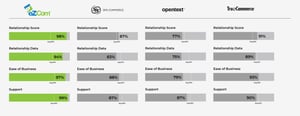Three tips to put your product in more places.
With the holiday season underway, do you find yourself wishing that your product was available in more retail outlets? Are you convinced that your brand is perfect for a specific retailer if they would only give you a chance to show them why? Do you want to be on the radar of more retail buyers?
We’re guessing the answers for most entrepreneurs are Yes, Yes, and Heck Yeah. It would be a truly unique supplier who answers differently. After all, the goal is more sales. And more retail locations help produce that outcome. While local stores remain a great asset for any brand, getting your products into a large national chain can create an extraordinary sales bump.
Now, of course, there’s the difficult part: how do you get wider retail distribution? How do you land more meetings with key retail buyers? How do you convince them that your product will generate the sales numbers they demand and close the deal?
It's hard work. But if you’re trying to get more business from retailer buyers, here are few tips that could help make it happen.
Tip #1: Offer additional services like drop shipping.
Major retailers need to move quickly to adapt to changing consumer demands. Offering certain services can be the difference maker when it comes to a buyer deciding to carry your product. Drop shipping, for instance, is a hot button for just about every retailer, as they seek to improve supply chain efficiency and be as responsive to marketplace demands as possible. Getting the right inventory mix at the specific times of the year is essential for retail success and the more you do to make that easier, the more likely you are to secure placement.
Make sure your EDI and order management supply chain have processes in place so you can ship direct-to-consumer or directly to stores. Some retailers will even want to you to ship directly to a single store, preserving the resources of their distribution centers. The more time and money you can shave off the cost of carrying your products, the more likely retailers are to find your products attractive.
Remember that friction creates resistance. Do more to make the process of carrying your products turnkey and you could find yourself rewarded with major retail chain placement. Even if you sacrifice some profit margins in the short-term, you could find yourself rewarded with a long-term, lucrative relationship.And don’t forget about merchandising. If you find a buyer is on the fence and you think placement in their store will drive your business forward, investing in display materials, special pricing or in-store demos could be another difference maker.
Tip #2: Target? Walmart? Neiman Marcus? Narrow your focus to the retailers that are right for your brand.
First, be realistic. When it comes to choosing the shelves you hope to see your products on, consider whether the retailer makes sense. Ask yourself if your product has the broad appeal that a store like Target or Walmart will demand. Consider whether you can manage the lower margins you’ll get in exchange for higher volume — more than a few suppliers, in their quest for placement in a big-box retailer, have found themselves losing money on orders. And don’t sell yourself short — if your products are too upscale for mass retail, you may find yourself erasing a lot of the hard work you have already put into branding.
What about the requirements of the retailer? If you’re a vendor on Amazon, for example, you’ll need to be able to meet their demands. Brick-and-mortar retailers often have very specific requirements for EDI compliance. Don’t forget that you only get one chance to make a first impression — when you land a big order from the buyer of a major retail chain, be sure your company is ready to put its best foot forward.
Remember that the retail landscape includes a lot more than the most well-known chains like Target or Walmart. There are scores of retail chains that are major players in specific parts of the country — Stein Mart, Meijer, Dillard’s, HEB, Fred Meyer — and some of them may be more receptive to your products than national store brands. Don’t overlook them.
Tip #3: Along with your product, walk in with some buzz.
Don’t think that the retailer wants to be the difference maker for your brand. Sure, placement in a huge national chain will do wonders for it, but retail buyers embrace products that arrive on the shelves with some momentum.
Work the social media channels. Don’t create a pile of different accounts, but make sure the ones you have generate followers and promote your brand identity. If you’re a fashion company, Instagram is critical.
Make sure the branding and messaging is consistent — retail buyers feel more confident about their decisions when they know exactly what they’re getting.
Get some media coverage. Whether its online, print, or broadcast, do whatever you can to put your company out there. Trade journals are often actively seeking content but aim for consumer outlets as well.
Finally, once you have generated some buzz, put it in a concise package that quickly demonstrates how much you’re doing to make your brand grow.
Keep at it.
Getting retail placement is never easy. You’ll need persistence and a thick skin. Being rejected doesn’t necessarily mean your product isn’t a winner — sometimes it’s just not right for the merchandise mix of a particular retailer or they already have a similar product in the category. What’s important is that you keep working to cultivate relationships with key decision makers and do everything possible to put your brand in the best light. When you do that, success will follow.






